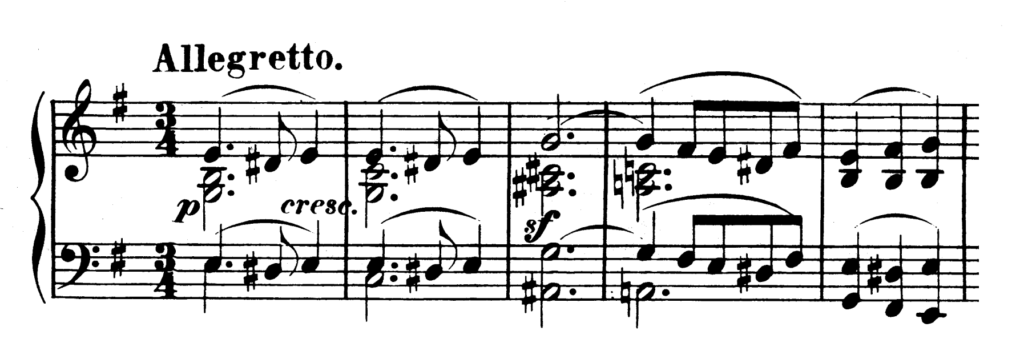Analysis
Contents
For the benefit of all pianists learning this work, we present to you a concise and easy to use analysis of Beethoven’s Piano Sonata No.9 in E major.
First Movement (Allegro)
Form: Sonata Form. E major.
EXPOSITION:
Bars 1-13: First Subject in E major (tonic). The first subject begins with a sentence of four bars upon tonic pedal point. Bar 5 is repeated an eighth lower (Bar 6), Bar 7 an eighth higher, and Bars 9-10 an eighth lower (Bars 11-12). The end of the first subject and the commencement of the connecting episode overlap.
Bars 13-22: Connecting episode. The connecting episode commences with the first two bars of the first subject. It modulates to F sharp major (dominant of second subject) in which key it ends, Bar 22.
Bars 22-57: Second Subject in B major. The two four-bar phrases with which the second subject commences, Bars 22-26 and 26-30 (the second being an imitation of the first a note lower), are repeated with slight alterations in the bass, Bars 30-38. The four-bar phrase, Bars 38-42, ending in dominant key is repeated, Bars 42-46. A new figure is then introduced, Bar 46, which is considered by some as the commencement of the Coda, The second subject closes, Bar 57, in the dominant key. (Note the consecutive fifths, Bar 53.)
Bars 57-61: Coda. The Bass of the Coda is formed upon the first subject. It modulates at Bar 61 from the dominant key back to the tonic.
Double bar and repeat.
DEVELOPMENT:
Bars 62-92: The development begins with a reminiscence of the first subject, but after a few bars an important episode is introduced, Bars 66-82, in the key of C major. Bars 82-92 are formed on the first subject, upon dominant pedal point.
RECAPITULATION:
Bars 92-104: First Subject (varied) in original key.
Bars 104-114: Connecting Episode. The connecting episode is of the same length as the original one, the first four bars of which, in the key of C, are varied and the keys altered so as to end in dominant key; it modulates to the dominant, Bar 107, by means of the chord of the augmented sixth.
Bars 114-149: Second Subject in E major (tonic). The second subject is transposed into the tonic key. (Note the consecutive fifths, Bar 145.)
Bars 149-End: Coda. The Coda is based upon the passage in Bars 57-61.
Second Movement (Allegretto)
Form: Ternary Form. Ab major.
FIRST PART:
The First Part is in Simple Binary form.
Bars 1-16: First Subject in E minor (tonic).
Bars 17-32: Development.
Bars 32-51: First Subject in original key.
Bars 51-62: Coda in tonic major key. The Coda consists of a figure, Bars 52-53, taken from the first subject (Bars 12-13), which is repeated five times on a tonic pedal.
SECOND PART:
The Second Part is in Simple Binary form.
Bars 1-16: First Subject in C major, ending in G major.
Double bar and repeat.
Bars 17-26: Episode. This episode is formed upon a pedal point on G (the dominant).
Bars 27-34: First Subject in original key.
Bars 35-38: Connecting Passage. The second movement ends at Bar 34, followed by four bars (Bars 34-38) modulating back to the key of tonic (E minor). Bars 27-38 occur again in the Coda.
THIRD PART:
First Part da capo.
Coda.
Third Movement (Allegro Commodo)
Form: Rondo Form. C minor.
FIRST PART:
Bars 1-16: First Subject in E major (tonic). The first subject begins with section of four bars ending on dominant seventh followed by two sections (the second being an exact transposition of the former an eighth lower) of two bars, forming a complete sentence in E. The first subject ends Bar 9. Bars 10-16 consists of a repetition of the first subject (shortened).
Bars 16-23: Episode. The episode is principally based upon a figure borrowed from the first subject, Bar 5. It is entirely in the key of the dominant.
Bars 23-31: Second Subject in B major. The second subject, Bars 23-27, is repeated (slightly varied), Bars 27-31. It consists of a four-bar sentence in B major.
Bars 32-40: First Subject in original key.
Bars 40-49: Episode. This episode begins with a reminiscence of first subject in E minor, and modulates to G major, on the dominant (pedal point) of which key the figure employed in the first episode occurs.
SECOND PART:
Bars 49-85: Third Subject in G major and E minor. The third subject is derived from the triplet accompaniment to the first subject.
THIRD PART:
Bars 85-93: First Subject in original key.
Bars 93-100: Episode. This episode resembles the first episode transposed into the key of A.
Bars 100-104: Second Subject in A major. Instead of being in tonic key the second subject re-appears in A major.
Bars 104-110: These bars constitute a passage formed upon the second subject leading back to the tonic key.
Bars 110-End: First Subject (varied) in original key. The varied appearance of the first subject has all the elements of a Coda. The figure upon which the episodes are formed re-appears at the end of the movement, Bars 127-128.









